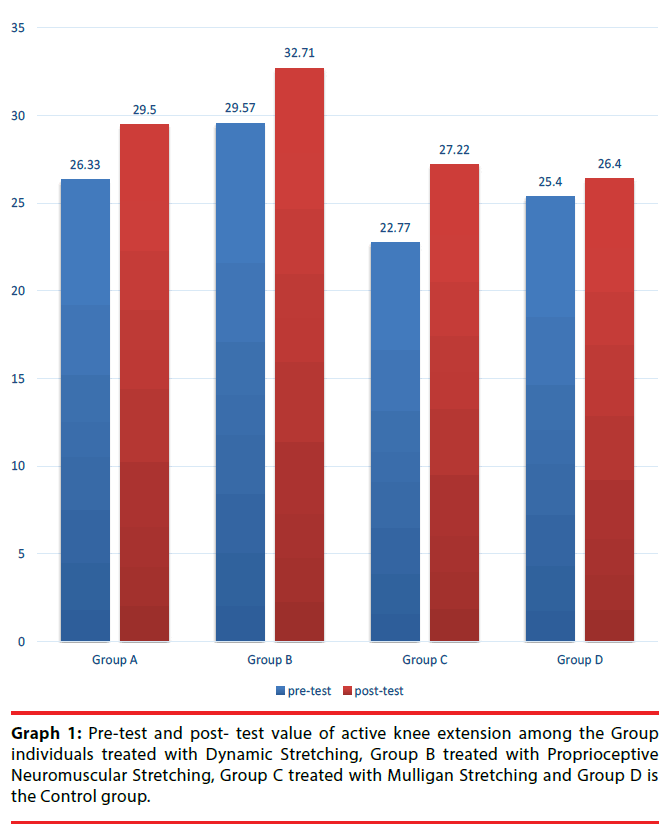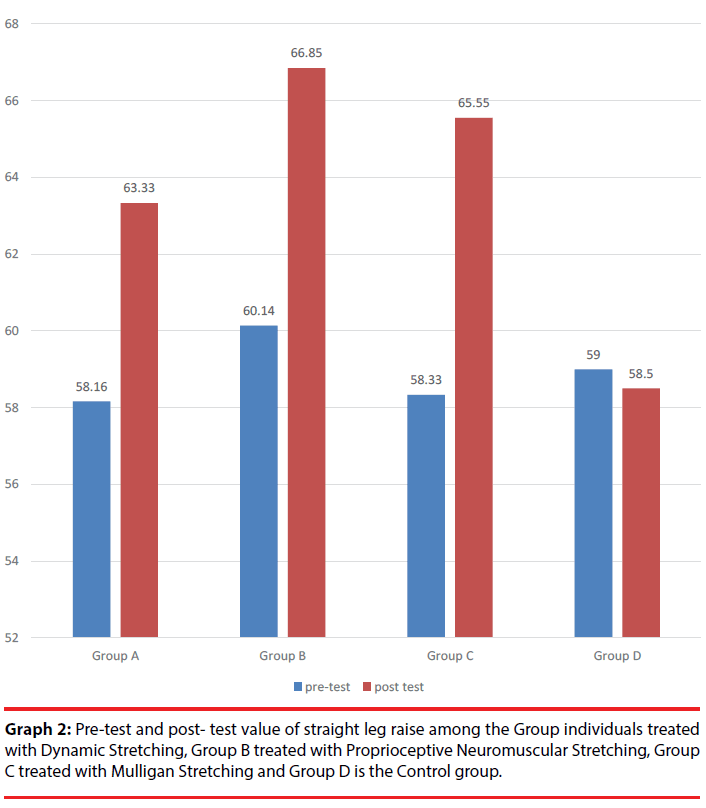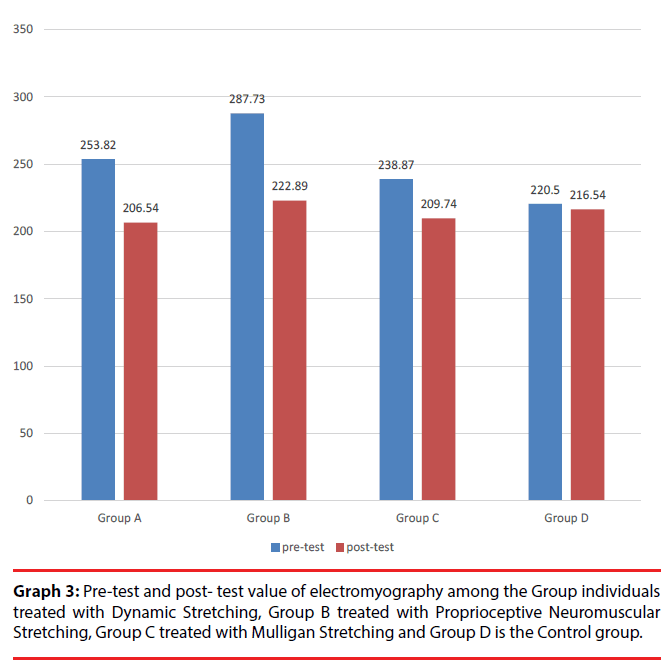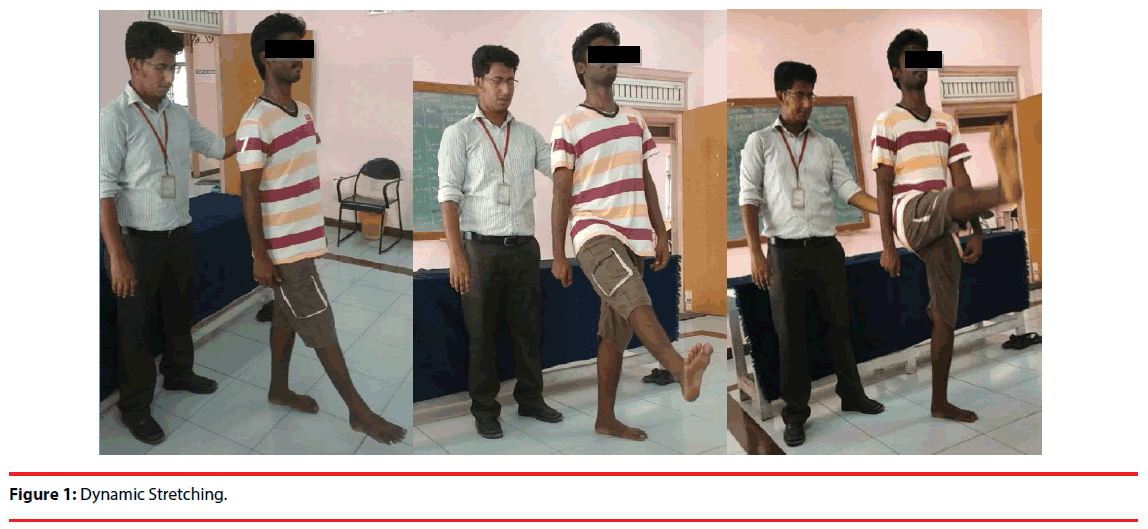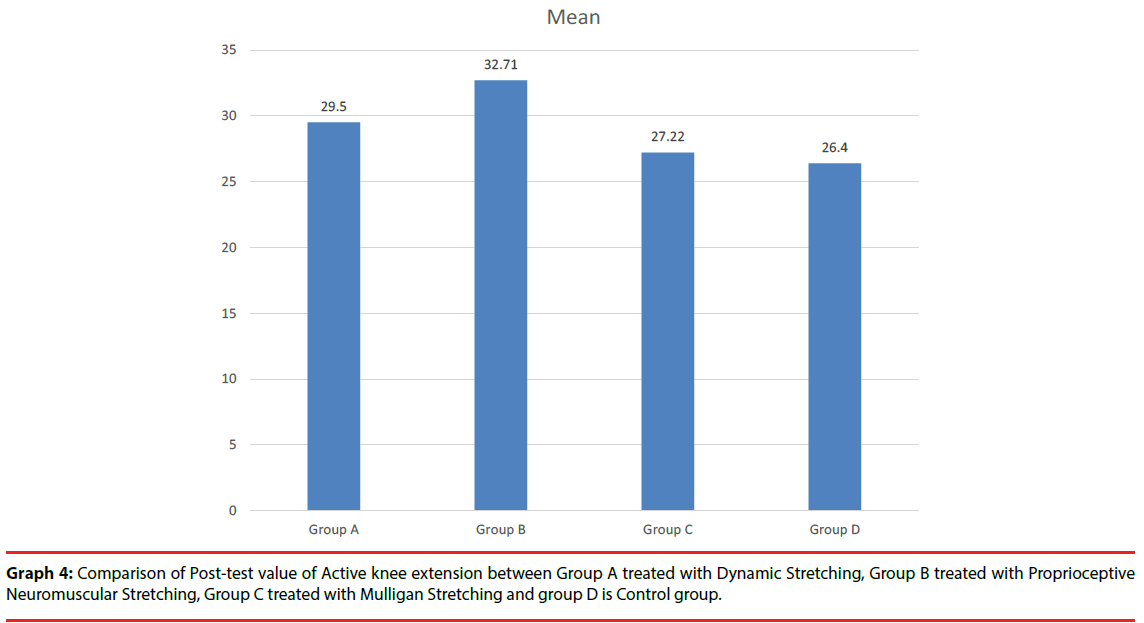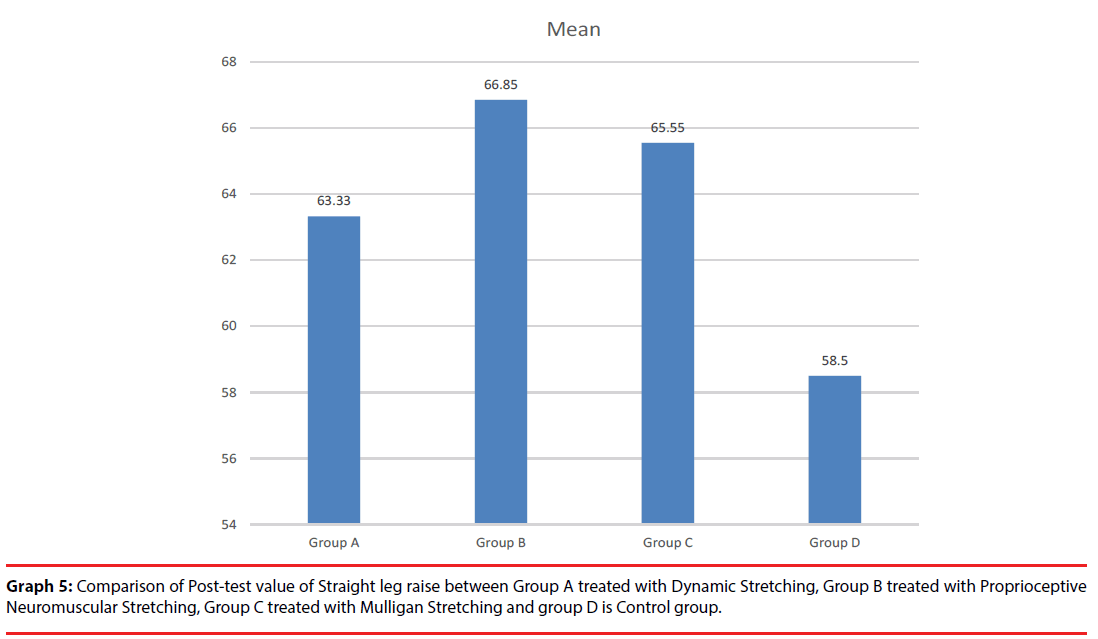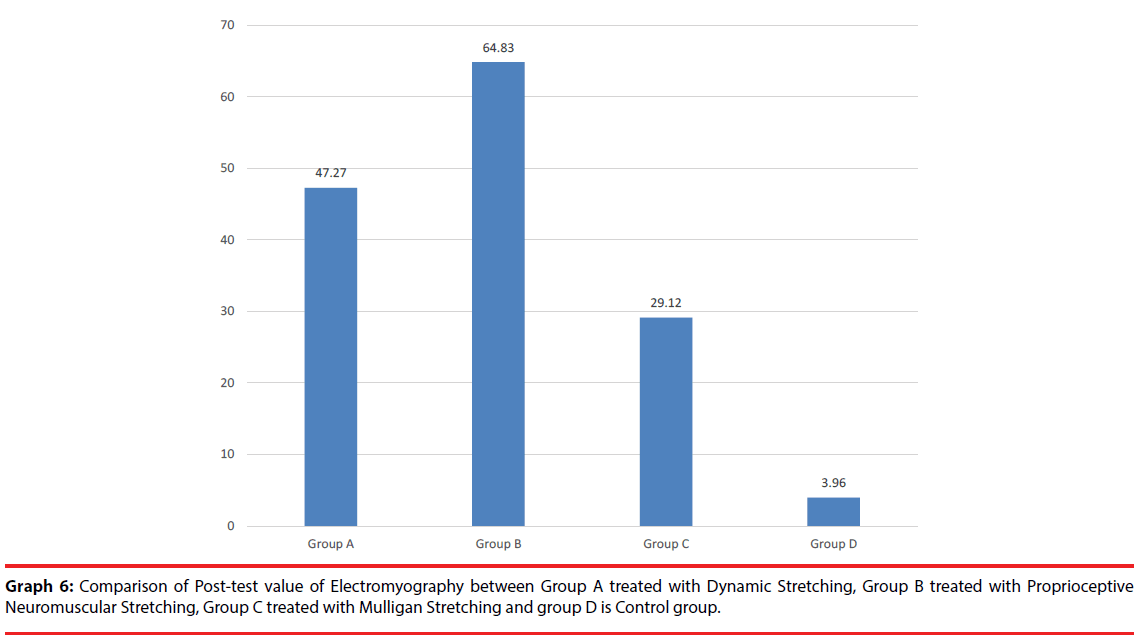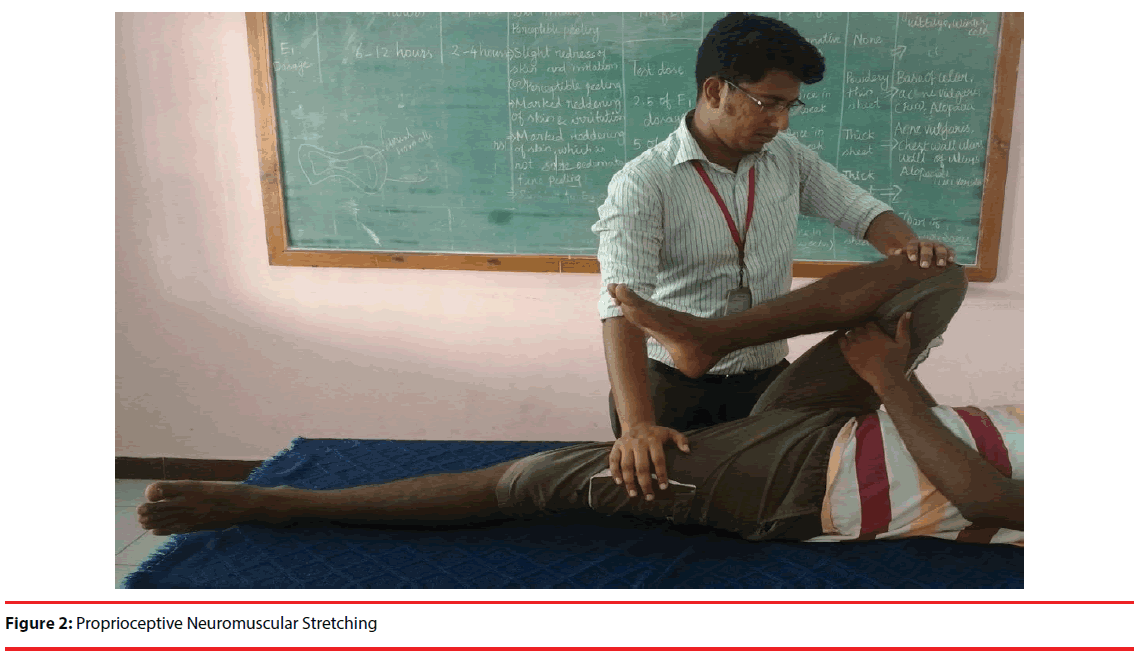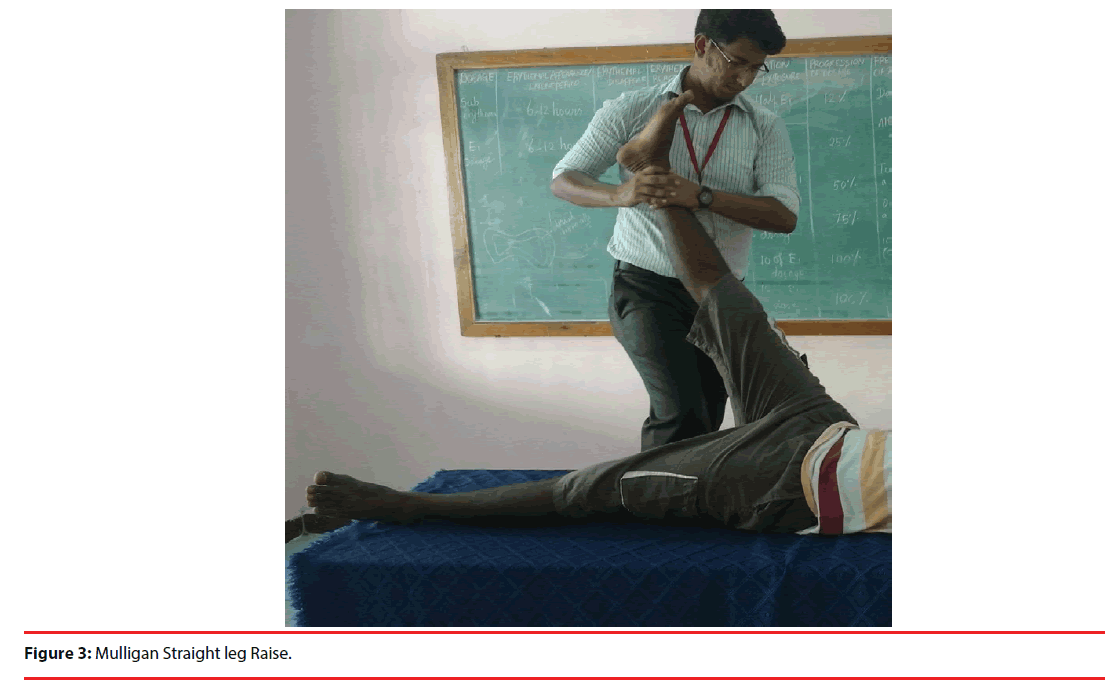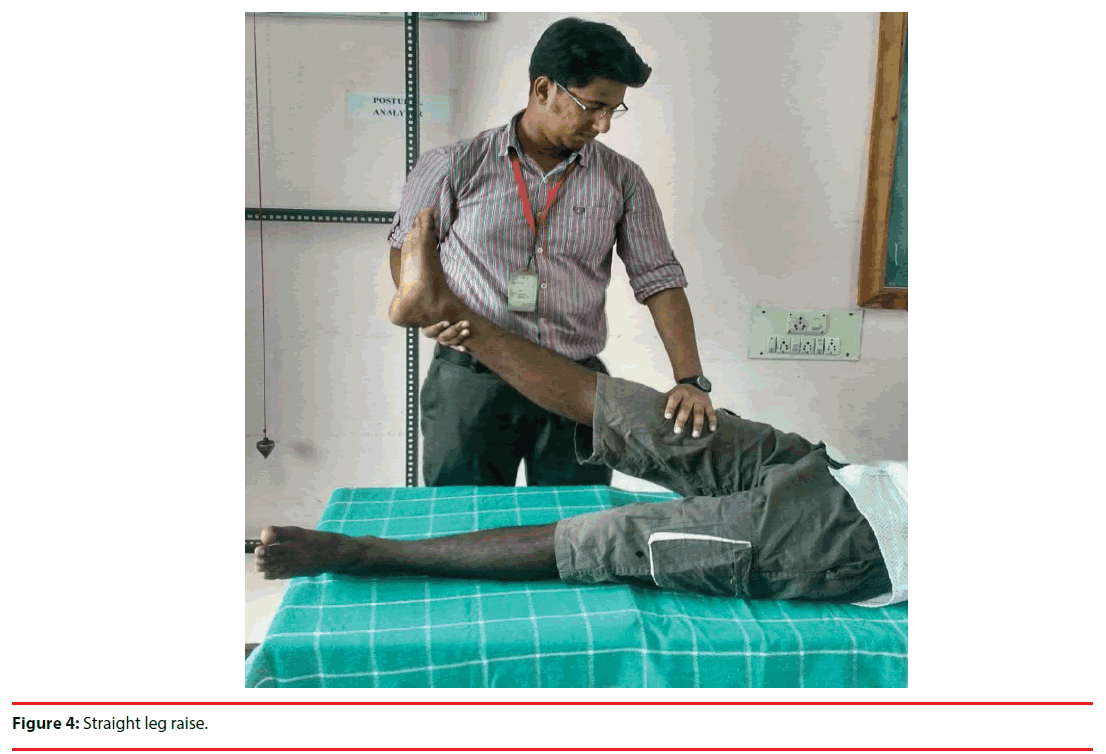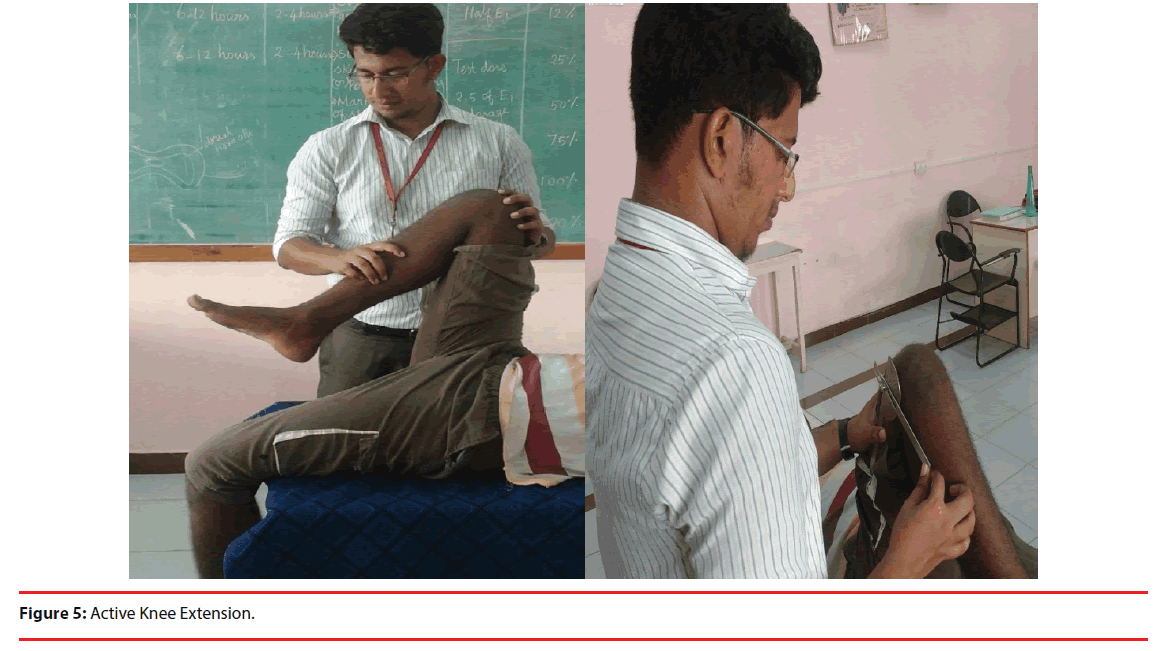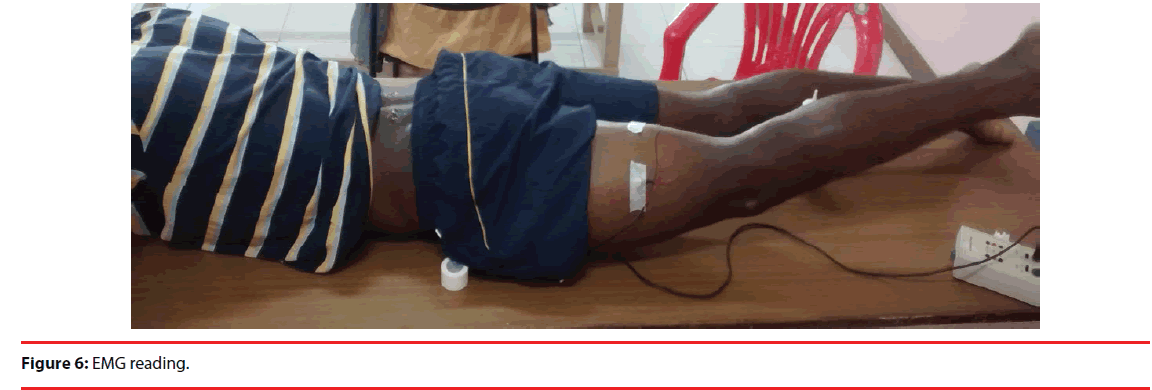Long Term Effects of Various Manual Techniques on Hip Flexion Range of Motion in Collegiate Players with Hamstring Tightness: A Randomized Control Trial
- Corresponding Author:
- K. Jeevanathan
Assistant professor, SRM College of Department of Physiotherapy, SRM Nagar, Kattankulathur - 603 203, Kancheepuram District, Tamil Nadu, India
Tel: +91-44- 27417000
E-mail: k.jeevan3113@gmail.com
Abstract
Hamstring strain is a common injury in sports like football, basketball, kabaddi and hockey which involve sprinting, kicking, high-speed skilled movements and jumping actions. It is a frustrating injury well known to physiotherapists, coaches, and athletes due to its prolonged periods of recovery, acute functional loss of performance, and subsequent increase of reoccurrence in athletes. Though there has been many studies comparing the effectiveness of the different stretching techniques to improve hamstring tightness but there is no evidence of follow-up to check whether the effect of the stretch persists
Keywords
Football; Basketball; Functional loss of performance
Introduction
Hamstring strain is a common injury in sports like football, basketball, kabaddi and hockey which involve sprinting, kicking, high-speed skilled movements and jumping actions. It is a frustrating injury well known to physiotherapists, coaches, and athletes due to its prolonged periods of recovery, acute functional loss of performance, and subsequent increase of reoccurrence in athletes [1-3].
A recent review indicated hamstring strain injuries have the highest recurrence rate in sports, ranging from 12 to 31% [4-6]. Hamstring strain injuries are caused due to a stretch, tear, or rip in the muscle or adjacent tissues of biceps femoris, semitendinosus or semimembranosus. It occurs mostly during the terminal swing phase, just before foot strike, during sprinting [6-8].
Flexibility which is a necessary component of normal biomechanical functioning in sports, is the ability of a muscle to lengthen resulting in improved range of motion (ROM) for one or more joint [9,10]. The ability of the muscle to produce tension is affected when the muscle’s resting length is altered [11].
Stretching is a major component of rehabilitation and activities related to sports, in order to restore optimum muscle length [12]. Studies suggest that the effect of stretching is persistent till a period of 90 min after a session [13].
Decreased Hamstring flexibility is suggested to be one of the predisposing factors for hamstring strains [14,15]. Hamstrings as they are easy to be evaluated for being biarticular muscles and as they stretched without obstruction by the joint capsule and ligaments are the most investigated muscle group in stretching studies [16]. Hamstring tightness may lead to biomechanical changes in low back and pelvis [12].
Dynamic stretching positively impacts on immediate physical performance but there is disagreement on how long the effect of stretching lasts [17-19]. Dynamic stretching involves moving the limb from its neutral position to end range, where the muscles are at their greatest length and then moving the limb back to its original position. This dynamic action is carried out in a smooth, controlled manner and is repeated for a specified time period [20- 24].
Proprioceptive neuromuscular facilitation is common among clinicians and researchers in increasing range of motion as their neurophysiological mechanisms are mediated by the Golgi Tendon and muscle spindle [18]. Proprioceptive neuromuscular facilitation stretching is for long being used as an alternate active stretching technique by both researchers and clinicians. Macefild reported that during hold-relax technique there is activation of Golgi tendon organ tension receptors within the hamstring muscle-tendon unit and with autogenic inhibition there is inhibition of hamstring muscle [24].
When there is limitation due to Hamstring tightness or low back pain Mulligan Traction Straight leg raise is used as an alternative procedure to increase the range [19]. The technique is indicated if, during its application the technique enables the impaired joint to move freely without pain or impediment. The direction of the applied force (translation or rotation) is typically perpendicular to the plane of movement or impaired action and in some instances it is parallel to the treatment plane
Aim of the Study
To find out the most effective stretching Technique to improve the hip range of motion in case of Hamstring tightness for a long-term period after the completion of intervention period.
▪ Need for the Study
Though there has been many studies comparing the effectiveness of the different stretching techniques to improve hamstring tightness but there is no evidence of follow-up to check whether the effect of the stretch persists. According to previous researches the immediate effect of stretching are mostly taken just after the completion of the intervention. Thus it was necessary to check whether the effect of stretching on the muscle length persists after the seizure of the technique. Moreover there is very little evidence of comparison of Dynamic Stretching, Proprioceptive Neuromuscular Stretching and Mulligan Stretching. Since the effect of detraining may start after 7 days therefore a period of 5 days gap was taken to take the post-test results.
Methodology
Study Design : Experimental Study
Study Type : Comparative Pre & Post Type
Sampling Method: Simple Random Technique
Sample Size : 35 Players
Setting : SRM UNIVERSITY
Study Duration : 5 Weeks
▪ Inclusion Criteria
Sex – males & females
Players must be within the age group of 18 to 25
Players should be in active sports or training at least for a period of minimum 2 years.
Straight leg raise should be between 30°-70°
Right-leg dominant
▪ Exclusion Criteria
Left- leg dominant
Straight leg raise greater than 70°
Players having hamstring injury within a period of 2 years.
Any current musculoskeletal pain.
History of low back pain in last two months.
Any indication of neurological disorder
▪ Materials Used
EMG machine
Electrode gel
Micro pore
Couch
Towels
Digital metronome
Sit and reach apparatus
Procedure
Samples were selected based on the inclusion and exclusion criteria. The purpose of the study was explained to the subjects and signed printed informed consent form was taken. A total of 54 players who are right leg dominant, involved in contact sports were screened on the nondominant side to find those having hamstring tightness. A group of 35 players were selected from football, hockey, basketball and kabaddi in accordance with the inclusion and exclusion criteria and were divided in to four groups as Group-A Dynamic stretching group, Group-B Proprioceptive neuromuscular facilitation stretching group, Group-C Mulligan stretching group and Group-D Control group.
In Group-A Dynamic stretching group the players were given stretching regime for 4 weeks on daily basis. In Group-B Proprioceptive neuromuscular facilitation group the players were trained for 4 weeks on daily basis. In Group-C Mulligan stretching group the players were trained for 4 weeks on daily basis. Group-D was the control group who continued with daily practice activity but did not perform the above exercises.
▪ Group A-Dynamic Stretching Group
• Player in standing position.
• Player actively swung the leg that was to be stretched forward into Hip flexion until a stretch is felt in posterior thigh.
• The knee was kept in extension & ankle in plantar flexion.
• It was continued for 30 seconds and repeated 3 times [5].
▪ Group B-Proprioceptive Neuromuscular Facilitation Stretching
• Player performed hold-relax technique on the non-dominant limb under supervision.
• Player performed an active straight leg raise with dorsiflexed ankle and toes
• The player raised his legs by turning the heel towards the opposite shoulder while clasping the hands around back of the thigh.
• Player performed hold contraction for 10 seconds and relax for 10 seconds, allowing the knee bend and is repeated for 3 times [7,8].
▪ Group C-Mulligan Straight Leg Raise Technique
• Subject was Supine.
• Traction was applied by the therapist in line with long axis of the leg and limb lifted actively by the subject through a pain–free range of Straight leg raise, until onset of discomfort.
• Knee kept extended
• If pain was felt during movement, then direction of leg was altered (slightly rotated, abducted or adducted).
• Three repetitions of pain free Traction straight leg raise was done [7-9].
▪ Outcome Measures
• Straight Leg Raise(SLR)
• Active Knee Extension(AKE)
• EMG activity pattern
▪ Electromyography reading
The subjects were asked to flex their non-dominant knee in prone position and the maximum active contraction was noted in the EMG.
The equipment was set to the following parameters.
• 100mv
• Sweep speed 100 ms/ div
• 200HZ to 2KHZ
The Electrode placement to collect EMG signals was as follow: mid distance between gluteal and popliteal fold on the muscle at a distance of 50% from superior to inferior and 50% from medial to lateral. The amplitude values for the hamstring were taken by placing the electrodes on their marked placements.
▪ Data Analysis
The recorded data were tabulated. The data was analysed using Statistical package for social science (SPSS) to present the findings as to which manual technique is more effective in long term. Data analysis was done with SPSS Software version 20.0 “P” value was set at less than 0.05 as significance for all analysis, “paired T” test was done
Results
According to Table 1 and Graph 1,the comparison of Pre-test and post-test for active knee extension within the group shows that the mean value for group A in pre-test and post-test is 26.33 & 29.50 respectively which is having a P value of 0.003 which is statistically significant at a confidence interval of 95% (P˂0.05) which shows that there was improvement after the intervention. The mean value for group B in pretest and post-test is 29.57 & 32.71 respectively which is having a P value of 0.005 which is statistically significant at a confidence interval of 95% (P˂0.05) which shows that there was improvement after the intervention. The mean value for group C in pre-test and post-test is 22.77 & 27.22 respectively which is having a P value of 0.000 which is statistically significant at a confidence interval of 95% (P˂0.05) which shows that there was improvement after the intervention. The mean value for group D in pretest and post-test is 25.40 & 26.40 respectively which is having a P value of 0.032 which is not statistically significant at a confidence interval of 95% (P˂0.05) which shows that there was no improvement after the intervention.
| Test | Mean | N | SD | DF | t Value | P Value | ||
|---|---|---|---|---|---|---|---|---|
| Pre | Post | Pre | Post | |||||
| Group A | 26.33 | 29.50 | 6 | 3.88 | 3.61 | 5 | 5.27 | 0.003 |
| Group B | 29.57 | 32.71 | 7 | 3.45 | 1.70 | 6 | 4.26 | 0.005 |
| Group C | 22.77 | 27.22 | 9 | 2.38 | 2.22 | 8 | 9.36 | 0.000 |
| Group D | 25.40 | 26.40 | 10 | 4.37 | 3.80 | 9 | 2.53 | 0.032 |
In case of Group A, there is statistical significance difference between pre and post-test
during active knee extension at 95% (P < 0.05).
In case of Group B, there is statistical significance difference between pre and post-test
during active knee extension at 95% (P < 0.05).
In case of Group C, there is statistical significance difference between pre and post-test
during active knee extension at 95% (P < 0.05).
In case of Group D,there is no statistical significance difference between pre and post-test
during active knee extension at 95% (P < 0.05).
Table 1: Pre-test and post- test value of active knee extension among the Group individuals treated with Dynamic Stretching, Group B treated with Proprioceptive Neuromuscular Stretching, Group C treated with Mulligan Stretching and Group D is the Control group.
According to Table 2 and Graph 2, the comparison of pre-test and post-test for straight leg raise within the group shows that the mean value for group A in pre-test and post-test is 58.16 & 63.33 respectively which is having a P value of 0.000 which is statistically significant at a confidence interval of 95% (P˂0.05) which shows that there was improvement after the intervention. The mean value for group B in pre-test and posttest is 60.14 & 66.85 respectively which is having a P value of 0.050 which is statistically significant at a confidence interval of 95% (P˂0.05)which shows that there was improvement after the intervention. The mean value for group C in pre-test and posttest is 58.33 & 65.55 respectively which is having a P value of 0.000 which is statistically significant at a confidence interval of 95% (P˂0.05) which shows that there was improvement after the intervention. The mean value for group D in pre-test and posttest is 59.00 & 58.50 respectively which is having a P value of 0.343 which is not statistically significant at a confidence interval of 95% (P˂0.05)which shows that there was no improvement after the intervention.
| Test | Mean | N | SD | DF | t Value | P Value | ||
|---|---|---|---|---|---|---|---|---|
| Pre | Post | Pre | Post | |||||
| Group A | 58.16 | 63.33 | 6 | 7.96 | 8.04 | 5 | 9.52 | 0.000 |
| Group B | 60.14 | 66.85 | 7 | 5.69 | 6.56 | 6 | 10.42 | 0.000 |
| Group C | 58.33 | 65.55 | 9 | 5.00 | 3.35 | 8 | 9.28 | 0.000 |
| Group D | 59.00 | 58.50 | 10 | 6.58 | 6.25 | 9 | 1.00 | 0.343 |
In Group A, there is statistical significance difference between pre and post-test during Straight
leg raise at 95% (P < 0.05).
In Group B, there is statistical significance difference between pre and post-test during Straight
leg raise at 95% (P < 0.05).
In Group C, there is statistical significance difference between pre and post-test during Straight
leg raise at 95% (P < 0.05).
In Group D, there is no statistical significance difference between pre and post-test during active
knee extension at 95% (P < 0.05).
Table 2: Pre-test and post- test value of straight leg raise among the Group individuals treated with Dynamic Stretching, Group B treated with Proprioceptive Neuromuscular Stretching, Group C treated with Mulligan Stretching and Group D is the Control group.
According to Table 3 and Graph 3, the comparison of pre-test and post-test for electromyography within the group shows that the mean value for group A in pre-test and post-test is 253.82 & 206.54 respectively which is having a P value of 0.000 which is statistically significant at a confidence interval of 95% (P˂0.05) which shows that there was improvement in amplitude after the intervention. The mean value for group B in pre-test and post-test is 287.73 & 222.89 respectively which is having a P value of 0.000 which is statistically significant at a confidence interval of 95% (P˂0.05)which shows that there was improvement in amplitude after the intervention. The mean value for group C in pre-test and post-test is 238.87 & 209.74 respectively which is having a P value of 0.009 which is statistically significant at a confidence interval of 95% (P˂0.05) which shows that there was improvement in amplitude after the intervention. The mean value for group D in pretest and post-test is 220.50 & 216.54 respectively which is having a P value of 0.399 which is not statistically significant at a confidence interval of 95% (P˂0.05)which shows that there was no improvement after the intervention (Figure 1).
| Test | Mean | N | SD | DF | t Value | P Value | ||
|---|---|---|---|---|---|---|---|---|
| Pre | Post | Pre | Post | |||||
| Group A | 253.82 | 206.54 | 6 | 23.94 | 21.35 | 5 | 11.47 | 0.000 |
| Group B | 287.73 | 222.89 | 7 | 44.99 | 38.55 | 6 | 11.90 | 0.000 |
| Group C | 238.87 | 209.74 | 9 | 115.11 | 92.68 | 8 | 3.42 | 0.009 |
| Group D | 220.50 | 216.54 | 10 | 29.85 | 29.27 | 9 | 0.88 | 0.399 |
In Group A, there is statistical significance difference between pre and post-test during
Electromyography at 95% (P < 0.05).
In Group B, there is statistical significance difference between pre and post-test during
Electromyography at 95% (P < 0.05).
In Group C, there is statistical significance difference between pre and post-test during
Electromyography at 95% (P < 0.05).
In Group D, there is no statistical significance difference between pre and post-test
during Electromyography at 95% (P < 0.05).
Table 3 : Pre-test and post- test value of electromyography among the Group individuals treated with Dynamic Stretching, Group B treated with Proprioceptive Neuromuscular Stretching, Group C treated with Mulligan Stretching and Group D is the Control group.
According to Table 4 and Graph 4, the comparison between the groups for the active knee extension the P value is 0.001 at confidence interval of 95% (P˂0.05) which shows that there is statistical significance difference between the groups. According to Table 5 and Graph 5, the comparison between the groups for the straight leg raise the P value is 0.034 at confidence interval of 95% (P˂0.05) which shows that there is no statistical significance between the groups
| Group | Mean | Sum of Square | df | f Value | P Value |
|---|---|---|---|---|---|
| Group A | 29.50 | 188.83 | 3 | 6.969 | 0.001 |
| Group B | 32.71 | ||||
| Group C | 27.22 | ||||
| Group D | 26.40 |
As the P Value is 0.001, therefore ANOVA shows there is statistical significance difference between pre and post-test during active knee extension at 95% (P < 0.05).
On carrying out Roger’s method after the completion of ANOVA, in case of Active Knee extension shows that Group 2 has significance with Group 3 & Group
4 but no significant difference with Group 1.
Table 4: Comparison of Post-test value of Active knee extension between Group A treated with Dynamic Stretching, Group B treated with Proprioceptive Neuromuscular Stretching, Group C treated with Mulligan Stretching and group D is Control group.
| Group | Mean | Sum of Square | df | f Value | P Value |
|---|---|---|---|---|---|
| Group A | 63.33 | 364.55 | 3 | 3.320 | 0.034* |
| Group B | 66.85 | ||||
| Group C | 65.55 | ||||
| Group D | 58.50 |
As the P Value is 0.034, therefore ANOVA shows there is statistical significance difference between pre and post-test during straight leg raise at 95%
(P < 0.05).
On carrying out Roger’s method after the completion of ANOVA, in case of Straight leg raise shows that Group 3 has significance with Group 2 but
no significant difference with Group 1 and Group 4.
Table 5: Comparison of Post-test value of Straight leg raise between Group A treated with Dynamic Stretching, Group B treated with Proprioceptive Neuromuscular Stretching, Group C treated with Mulligan Stretching and group D is Control group.
According to Table 6 and Graph 6, the comparison between the groups for the electromyography the P value is 0.870 at confidence interval of 95% (P˂0.05) which shows that there is no statistical significance between the groups.
| Group | Mean | Sum of Square | df | f Value | P Value |
|---|---|---|---|---|---|
| Group A | 47.27 | 2189.007 | 3 | 0.236 | 0.870* |
| Group B | 64.83 | ||||
| Group C | 29.12 | ||||
| Group D | 3.96 |
As the P value is 0.870, ANOVA shows there is no statistical significance difference between pre and post-test during Electromyography at 95% (P < 0.05).
Table 6: Comparison of Post-test value of Electromyography between Group A treated with Dynamic Stretching, Group B treated with Proprioceptive Neuromuscular Stretching, Group C treated with Mulligan Stretching and group D is Control group.
Discussion
The review of existing literature comparing the effectiveness of the dynamic stretching, proprioceptive neuromuscular facilitation stretching and mulligan stretching gives a picture about which method is more effective. It suggests that mulligan technique is more effective when compared at the end of the intervention immediately. But there was no study to suggest whether there is a long term effect which persists after the intervention is ceased. There are conflicting results regarding the effects of different stretching methods based on the recent literatures. Few studies have shown the efficiency of active stretching exercises, especially Proprioceptive neuromuscular stretching (Figure 2), in increasing muscle flexibility and joint range of motion [20- 22]. However, some proof exists indicating the similar efficacy of dynamic and active stretching techniques as well as the superiority of dynamic stretching [3,23-25].
These difference in responses to stretching were attributed to some mechanical and neural factors. Konrad and Tilp stated that increased range of motion following stretching was because of an altered perception to stretch, and pain or stretch tolerance are by the adaptations of nociceptive nerve endings not because of altered muscular or tendon structures [26].
Besides the traditional beliefs, recent literature suggests that decreases in the response amplitude of the H reflex and muscle stretch reflexes following contraction of a stretched muscle is because of presynaptic inhibition of the muscle spindle sensory signal. A number of studies have investigated the effect of Proprioceptive neuromuscular facilitation stretching along with other stretching techniques. Hold-relax technique was used mostly as Proprioceptive neuromuscular facilitation stretching in previous studies. Youdas compared two Proprioceptive neuromuscular facilitation stretching techniques and detected progressive changes in hamstring muscle length and range of motion of knee after a session of holdrelax with antagonist contraction [8]. It was found that there was a significant increase in hamstring flexibility after a sequence of five modified hold relax stretches [27]. Bonnar confirmed the benefit of hold-relax technique in increasing hip flexion ROM for three separate contraction times: 3, 6 and 10 seconds [28]. Similarly, the 10-second hold-relax technique of 3 sets followed by 10 repetitions in each as Proprioceptive neuromuscular facilitation stretching was performed in this study. Results of this study shows a significant increase in hip ROM following 4-week of PNF stretching, which was superior to typical dynamic stretching (Figure 1).
Previously it was found that a significant increase in range of Straight leg raise was found after traction straight leg raise technique in patients with both low back pain and also in healthy subjects [28-34].
In this study 35 players who were selected from total after screening went through the stretching techniques after being divided randomly into four groups. Four players were unable to continue with the study and left midway. The post test revealed that the long term effect of Proprioceptive neuromuscular facilitation stretching was more prominent than the other three groups [35,36]. Both in case of Active knee extension and in case of Electromyography the Proprioceptive neuromuscular facilitation group was found to be the one showing more significant change than Mulligan which resulted in the null hypothesis being proved true (Figures 3 and 4).
The increase in Straight leg raise Range of motion was mainly due to the increase in stretch tolerance of structures of posterior hip joint. In this context, Traction straight leg raise technique increases the stretch tolerance of hamstring muscles (Figures 5 and 6).
Conclusion
After 4-week stretching interventions (Dynamic stretching, Mulligan Traction straight leg raise technique and Proprioceptive neuromuscular facilitation stretching) and taking a post-test after the ceasing of the stretching after one week significant improvements are found in hip flexion range of motion. Moreover, our results revealed that Proprioceptive neuromuscular facilitation stretching is better to Dynamic Stretching and Mulligan Straight leg raise technique This intervention can be used alternatively in order to bring more effective changes in hip flexion range of motion in players with unilateral hamstring tightness.
Limitations
• Sample size is small
• Males were only available for the study.
• Contact sports players were the only ones to participate in study
• Only amplitude is taken for the study samples through EMG
▪ Recommendations
• Future studies can be done for longer duration
• The timing and onset of the muscle activity in addition to amplitude can be recommended.
References
- Ekstrand J, Gillquist J. Soccer injuries and their mechanisms: a prospective study. Med. Sci. Sports. Exerc15(3), 267–270 (1983).
- Garrett WE Jr. Muscle strain injuries. Am. J. Sports. Med 24(6 Suppl):S2–8 (1996).
- Askling C, Karlsson J, Thorstensson A. Hamstring injury occurrence in elite soccer players after preseason strength training with eccentric overload. Scand. J. Med. Sci. Sports 13(14), 244–250 (2003).
- Yu B, Queen RM, Abbey AN, et al. Hamstring muscle kinematics and activation during over ground sprinting. J. Biomech 41(15), 3121-3126 (2008).
- Brughelli M, Nosaka K, Cronin J. Application of eccentric exercise on an Australian Rules football player with recurrent hamstring injuries. Phys. Ther. Sport 10(2),75-80 (2009).
- Hoskins W, Pollard H. The management of hamstringinjury-Part 1: Issues in diagnosis. Man. Ther 10(2), 96-107 (2005)
- Hunter DG, Speed CA. The assessment and management of chronic hamstring/posterior thigh pain. Best. Pract. Res. Clin. Rheumatol 21(2), 261-277 (2007)
- Arnason A, Sigurdsson SB, Gudmundsson A, et al. Risk factors for injuries in football. Am. J. Sports. Med 32(Suppl 1), 5S–16S (2004).
- Zachezewski JE. Improving flexibility. In: Scully RM, Barnes MR, eds. Physical Therapy. Philadelphia, PA: JB Lippincott; 698-699 (1989).
- Hopper D, Deacon S, Das S, et al. Dynamic soft tissue mobilisation increases hamstring flexibility in healthy male subjects. Br. J. Sports. Med 39:594-598 (2005).
- Winters MV, Blake CG, Trost JS, et al. Passive versus active stretching of hip flexor muscles in subjects with limited hip extension: A randomized clinical trial. Phys. Therapy 84(9), 800-807 (2004)
- Meroni R, Cerri CG, Lanzarini C, et al. Comparison of active stretching technique and static stretching technique on hamstring flexibility. Clin. J. Sport. Med 20:8-14 (2010).
- Möller M, Ekstrand J, Oberg B, et al. Duration of stretching effect of range of motion in lower extremities. Arch. Phys. Med. Rehabil 66(3), 171-173 (1985).
- Hopper D, Deacon S, Das S, et al. Dynamic soft tissue mobilisation increases hamstring flexibility in healthy male subjects. Br. J. Sports. Med 39(9), 594–598 (2005)
- Hall T, Anuar K, Darlow B, et al. The effect of Mulligan Traction Straight Leg Raise in participants with short hamstrings. Ann. Acad. Med. Singapore 32(5), 56-57 (2003).
- Ylinen JJ, Kautiainen HJ, Hakkinen AH. Comparison of active, manual and instrumental straight leg raise in measuring hamstring extensibility. J. Strength. Cond. Res 24(4), 972-927 (2010).
- Marek SM, Cramer JT, Fincher AL, et al. Acute effects of static and proprioceptive neuromuscular facilitation stretching on muscle strength and power output. J. Athl. Train 40(2),94-103 (2005).
- Yıldırım MS, Ozyurek S, Tosun OÇ, et al. Comparison of effects of static, proprioceptive neuromuscular facilitation and Mulligan stretching on hip flexion range of motion: a randomized controlled trial. Biol. Sport 33(1), 89-94 (2016).
- Murphy DR. Dynamic range of motion training: an alternative to static stretching. Chiropractic Sports Medicine 8(2), 59-66 (1994).
- Fasen JM, O’Connar AM, Schwartz SL, et al. A randomized controlled trial of hamstring stretching: Comparison of four techniques. J. Strength. Cond. Res 23(2), 660-667.
- Chalmers G. Re-examination of the possible role of Golgi tendon organ and muscle spindle reflexes in proprioceptive neuromuscular facilitation muscle stretching. Sports. Biomech 3(1), 159-183 (2004).
Sharman MJ, Cresswell AG, Stephan R. Proprioceptive neuromuscular facilitation stretching mechanisms and clinical implications. Sports. Med 36(11), 929-939 (2006). - O’Sullivian K, Murray E, Sainsbury D. The effect of warm-up, static stretching and dynamic stretching on hamstring flexibility in previously injured subjects.
BMC. Musculoskeletal. Disord 10, 37-45 (2009). - Davis DS, Ashby PE, McCale KL, et al. The effectiveness of 3 stretching techniques on hamstring flexibility using consistent parameters. J. Strength. Cond. Res 19:27-32 (2005).
- Willy RW, Kyle BA, Moore SA, et al. Effect of cessation and resumption of
static hamstring muscle stretching on joint range of motion. J. Orthop. Sports. Phys. Ther 31(3), 138-144 (2001). - Konrad A, Tilp M. Increased range of motion after static stretching is not due to changes in muscle and tendon structures. Clin. Biomech. (Bristol, Avon) 29(6), 636-642 (2014).
- Macefild G, Hagbarth KE, Gorman R, et al. Decline in spindle support to alpha motoneurons during sustained voluntary contractions. J. Physiol 440,497-512 (1991).
- Spernoga SG, Uhl TL, Arnold BL, et al. Duration of maintained hamstring flexibility after a one-time, modified hold-relax stretching protocol. J. Athl. Training 36(1), 44-48 (2001).
- Bonnar BP, Deivert RG, Gould TE. The relationship between isometric contraction durations during hold-relax stretching and improvement of hamstring flexibility. J. Sports. Med Phys. Fitness 44(33), 258-261(2004).
- Kendall FP, McCreary EK. Muscles Testing and Function. Baltimore MD: Williams & Wilkins. (1993).
- Hopper D, Deacon S, Das S, et al. Dynamic soft tissue mobilisation increases hamstring flexibility in healthy male subjects. Br. J. Sports. Med 39(9), 594–598 (2005).
- Marek SM, Cramer JT, Fincher AL, et al. Acute effects of static and proprioceptive neuromuscular facilitation stretching on muscle strength and power output. J. Athl. Train. 40(2), 94-103 (2005).
- Collins N, Teys P, Vicenzino B. The initial effect of Mulligan Mobilisation with movement technique on dorsiflexion and pain in subacute ankle sprains. 9(2),77-82 (2004).
- Murphy DR. Dynamic range of motion training: An alternative to static stretching. Chiropractic. Sports. Med 859-866 (1994).
- Hall T, Cacho A, McNee C, et al. Effect of the Mulligan Traction Straight leg raise technique on range of movement. J. Man. Manip. Ther 18,128-133 (2013).
- Morris CM, Matthews M. Inter-tester reliability of a self-monitored active knee extension test. Elsevier 9(4), 256-259 (2005).
- Barbosa G de, Dantas AD, Silva BR, et al. Intra-rater and Inter-instrument Reliability on Range of Movement of Active Knee Extension. Scielo. 23, (2017).
